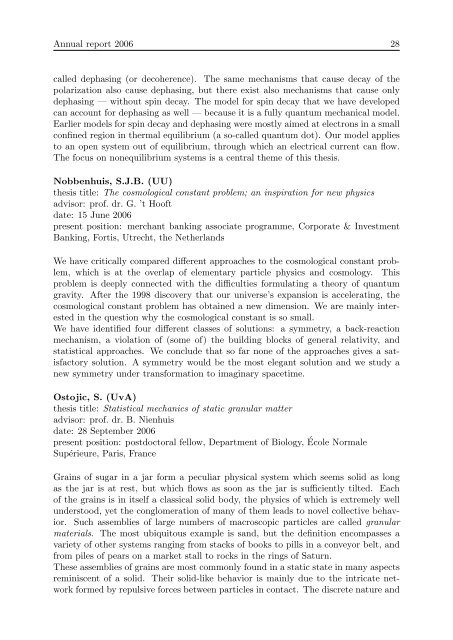ANNUAL REPORT 2006
ANNUAL REPORT 2006
ANNUAL REPORT 2006
- No tags were found...
Create successful ePaper yourself
Turn your PDF publications into a flip-book with our unique Google optimized e-Paper software.
Annual report <strong>2006</strong> 28<br />
called dephasing (or decoherence). The same mechanisms that cause decay of the<br />
polarization also cause dephasing, but there exist also mechanisms that cause only<br />
dephasing — without spin decay. The model for spin decay that we have developed<br />
can account for dephasing as well — because it is a fully quantum mechanical model.<br />
Earlier models for spin decay and dephasing were mostly aimed at electrons in a small<br />
confined region in thermal equilibrium (a so-called quantum dot). Our model applies<br />
to an open system out of equilibrium, through which an electrical current can flow.<br />
The focus on nonequilibrium systems is a central theme of this thesis.<br />
Nobbenhuis, S.J.B. (UU)<br />
thesis title: The cosmological constant problem; an inspiration for new physics<br />
advisor: prof. dr. G. ’t Hooft<br />
date: 15 June <strong>2006</strong><br />
present position: merchant banking associate programme, Corporate & Investment<br />
Banking, Fortis, Utrecht, the Netherlands<br />
We have critically compared different approaches to the cosmological constant problem,<br />
which is at the overlap of elementary particle physics and cosmology. This<br />
problem is deeply connected with the difficulties formulating a theory of quantum<br />
gravity. After the 1998 discovery that our universe’s expansion is accelerating, the<br />
cosmological constant problem has obtained a new dimension. We are mainly interested<br />
in the question why the cosmological constant is so small.<br />
We have identified four different classes of solutions: a symmetry, a back-reaction<br />
mechanism, a violation of (some of) the building blocks of general relativity, and<br />
statistical approaches. We conclude that so far none of the approaches gives a satisfactory<br />
solution. A symmetry would be the most elegant solution and we study a<br />
new symmetry under transformation to imaginary spacetime.<br />
Ostojic, S. (UvA)<br />
thesis title: Statistical mechanics of static granular matter<br />
advisor: prof. dr. B. Nienhuis<br />
date: 28 September <strong>2006</strong><br />
present position: postdoctoral fellow, Department of Biology,<br />
Supérieure, Paris, France<br />
École Normale<br />
Grains of sugar in a jar form a peculiar physical system which seems solid as long<br />
as the jar is at rest, but which flows as soon as the jar is sufficiently tilted. Each<br />
of the grains is in itself a classical solid body, the physics of which is extremely well<br />
understood, yet the conglomeration of many of them leads to novel collective behavior.<br />
Such assemblies of large numbers of macroscopic particles are called granular<br />
materials. The most ubiquitous example is sand, but the definition encompasses a<br />
variety of other systems ranging from stacks of books to pills in a conveyor belt, and<br />
from piles of pears on a market stall to rocks in the rings of Saturn.<br />
These assemblies of grains are most commonly found in a static state in many aspects<br />
reminiscent of a solid. Their solid-like behavior is mainly due to the intricate network<br />
formed by repulsive forces between particles in contact. The discrete nature and
















